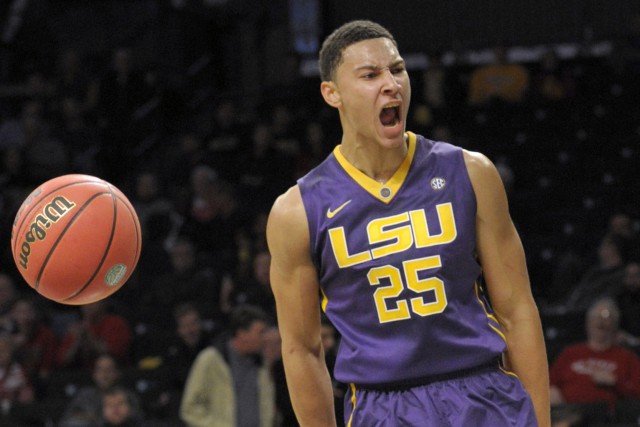
New 30-Second Shot Clock Affecting College Basketball Totals
Believe it or not, there was a time where the NCAA did not utilize a shot clock for college basketball. This led to incredibly low-scoring games including a game from December 15, 1973 where Temple lost to Tennessee by the final score of 11-6. With no shot clock, Temple coach Don Casey opted to stall on offense while his opponent sat back in their zone defense. In terms of excitement, it was the basketball equivalent of Ben Stein reading an iTunes agreement.
More than a decade after this infamous contest, the NCAA introduced a 45-second shot clock for the men’s game. Eight years later, they reduced the shot clock to 35-seconds for the 1993-94 season. This was in stark contrast to women’s game which utilized a 30-second shot clock and the NBA where the time limit was only 24 seconds.
On June 8, 2015, the NCAA formally voted to reduce the shot clock from 35-seconds to 30-seconds, and it became obvious that this change would have dramatic ramifications for college basketball bettors. Specifically, we understood that a shorter shot clock would cause an increase in the number of possessions per game, which would subsequently lead to higher-scoring games.
Our research revealed that between 2004 and 2015, the under had gone 18,107-17,761 (50.5 percent). In these games, the average closing total at Pinnacle — one of the market-setting offshore sportsbooks — was 136.23.
The table below displays the average closing total and the under record for each of the past 11 seasons.
| Year | Average Total | Under Record | Win Rate |
|---|---|---|---|
| 2004-05 | 137.51 | 959-969 | 49.7% |
| 2005-06 | 136.38 | 1,592-1,551 | 50.7% |
| 2006-07 | 137.09 | 1,626-1,730 | 48.5% |
| 2007-08 | 137.17 | 1,743-1,704 | 50.6% |
| 2008-09 | 135.68 | 1,673-1,677 | 49.9% |
| 2009-10 | 137.13 | 1,677-1,576 | 51.6% |
| 2010-11 | 135.99 | 1,830-1,813 | 50.2% |
| 2011-12 | 134.22 | 1,871-1,837 | 50.5% |
| 2012-13 | 133.69 | 1,539-1,541 | 50.0% |
| 2013-14 | 140.47 | 1,983-1,730 | 53.4% |
| 2014-15 | 133.17 | 1,614-1,633 | 49.7% |
| Overall | 136.23 | 18,107-17,761 | 50.5% |
Along with the newly implemented 30-second shot clock, the men’s basketball rules committee voted to reduce the number of time outs and extend the arc underneath the basket from 3-feet to 4-feet. These rules were meant to improve the pace of play and help reduce the number of collisions underneath the basket.
Our hypothesis was that oddsmakers would increase the average total, and we actually had an educated guess about how many points it would increase by. Last season’s National Invitational Tournament (NIT) used experimental rules including a 30-second shot clock and a 4-foot restricted area arc, and the average total rose by 8.5-points at CRIS.
This sample size was small, but the shortened shot clock had caused the average total to increase by just over 6 percent. We believed that the average square bettor would continue pounding the over with little regard for the elevated total. Since the under has performed exceptionally well in games with high totals, we thought that this development would lead to profitable returns for under bettors.
| Year | Average Total | Under Record | Win Rate |
|---|---|---|---|
| 2003-15 | 136.23 | 18,107-17,761 | 50.5% |
| 2015-16 | 144.74 | 400-390 | 50.6% |
As you can see, the average over/under has increased by 8.51 points per game — nearly the exact same figure that it increased during the NIT last season. Despite these enlarged totals, the under has maintained its slight historical edge.
This development is extremely important for all Bet Labs users, especially for College Basketball over/under systems or spread systems which utilize the closing total filter. Case in point, last year we published an article highlighting value on the under in early season tournaments.
The featured system explained why bettors should take the under in neutral site games when the total is at least 145-points. This system posted a 10-4 record (+5.32 units) in 2014, but that record ballooned to 62-44 (+12.64 units) this season. That means the number of current games matches increased by over 750 percent!
We should note that the under has historically won at a lower rate in conference games (50.2 percent) than non-conference games (51.2 percent). With conference games typically starting in early January, it will be interesting to see whether sportsbooks will shade their lines and increase the average total.
Don’t forget to visit our free College Basketball odds page for the latest odds, public betting trends, injuries and more.
If you have any questions for the staff at Sports Insights, please contact our customer service department at 877-838-2853, email us at help@sportsinsights.com or utilize our live chat to speak directly with a representative.
David Solar is the Content Manager for Sports Insights and can be reached directly at David@sportsinsights.com.

Fazzer
12/09/2015 at 2:25 pmI was curious about this , thanks for the updates!
MP
12/10/2015 at 2:48 amThese stats are not too reliable, since Pinnacle has offered a ton of CBB totals some years, and only for major games in other years.
David Solar
12/10/2015 at 1:52 pmFor the few games in which Pinnacle does not post a total, we would default to the market consensus. It’s definitely true that many market-setting sportsbooks won’t open their NCAAB totals until shortly before game time.
MP
12/12/2015 at 7:15 amThe problem this year is that most of the games you have totals for are not from Pinnacle. They have barely offered *any* totals this season. So your database is using Bookmaker for most of its total this season, which makes an apples to apples comparison of average totals between seasons difficult.